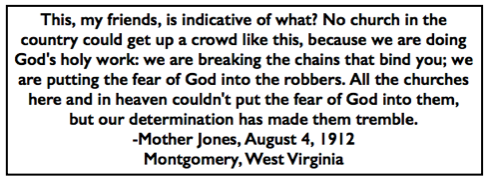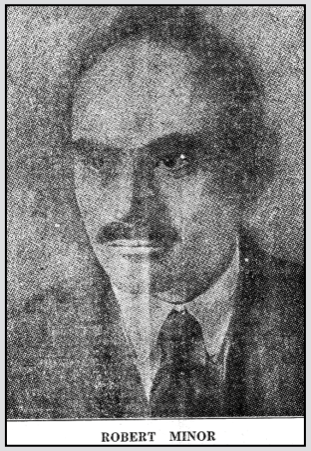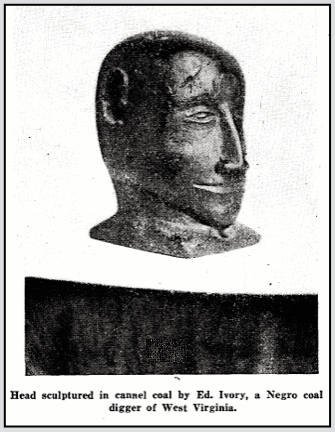 ———-
———-
Hellraisers Journal – Monday August 2, 1920
Robert Minor Travels to West Virginia to Report on Coalfield Wars
From the New York Liberator of August 1920:
I of IV
As the train from Charlottesville ran through the Blue Ridge Mountains, a Negro looked out of the window, arose and walked from the stuffy compartment “for colored people” into a more comfortable car marked “for whites.” From that I knew the train had passed into West Virginia. The Negro sat down facing a weatherbeaten man with a white mustache and a broad-brimmed hat. The white man’s face did not change expression at the Negro’s entrance, and from that I knew that the white man was a mountaineer of the West and not an inhabitant of Old Virginia.
From Chesapeake Bay, across the Blue Ridge Mountains and away up around the southwest corner o£ Pennsylvania, used to extend the domain of Old Virginia. But the rich planters of the eastern valleys went to war against the Union, and the “po’ white” men hoeing their corn alone on the mountains and not owning any n——, refused to follow. The new State of West Virginia was made of these soft green mountains and lonely cabins and corn patches.
For another generation the people of the mountains hoed their corn. Then somebody discovered that the green-covered mountains were made of coal. The railroads began to scratch their way through the green, and to nose out the great black insides that were worth more than the cabins and corn patches. Men from Northern cities took part in West Virginia affairs and soon could prove with legal papers that they owned the black contents of the mountains and the green surface, too.
Many mountain families quit hoeing corn. They settled near the coal pits where regular wages and store clothes seemed to offer more of a living. The population passed from the outside of the mountains to the inside of them, and the grip of the men with the title deeds dosed down hard upon all.
As my train ran down the valley, the mountains on either side showed me the black scars of the title deeds. All is owned by the coal companies; nothing in sight is free but the wild water of New River churning through the boulders, and the n—– in the white men’s compartment of the train. Folks work in company, mines, live in company shacks, learn in company schools and company churches, from company teachers and company preachers, and the wages that brought them there they pay to company stores for company food and clothes. Coal company Governors rule the mountaineers, coal company courts judge them, and coal company sheriffs-in most places-drive them back into the coal pits when they rebel.
Coal company detectives board the trains that enter the more southern counties to look over the passengers. Labor organizers are taken out and blackjacked and left to die in the woods. The counties are divided like Balkan States, each county line a frontier where coal company “passports” may be demanded. For eighteen years, wars have raged through these mountains, and men have died in scores and hundreds. For eighteen years-since 1902, when the mountaineers first found that they had been trapped in the black holes.
The coal companies had a hard time holding down the mountaineers in the first great strike, in 1902, when the mountaineers left off the feudal way of thinking that goes with hoeing corn alone, and began to think as masses of coal miners.
Then came “Old Man Baldwin” with a system. As head of the “Baldwin-Felts Detectives, Inc.,” he took a contract to break the strike for a sum which some think was $200,000. His system was to import mine-guards of the convict-detective kind from the cities, and to organize the strike-breaking business into a large semi-military campaign. He criss-crossed the country in dead-lines against labor organizers and garrisoned coal camps under the nozzles of machine-guns. The men of the mountains had always been armed. Under Baldwin all that could be caught or whose weapons could be found were disarmed. When disarmed they were driven by club and gun into the coal pits or out of the country.
Here my train turns down the Kanawha Valley into “Union territory,” won back from the blackjack men by the mountaineer coal diggers in wars of rifle and pistol and gatling gun between the years of 1902 and 1913. The whole valley was won by the miners, in the strike of 1902, and the upper part of it was lost again in 1904, after which it lived for several years under the terrorism of Baldwin and of Charley Cabell, leader of the mine owners of Cabin Creek.
The third big strike broke out at Paint Creek in 1912, when the Baldwin-Felts gang slaughtered men so frankly that the authorities felt obliged to indict eight of them for murder (and released them under light bond). And there was a grand “rabbit drive” of men, women and children down Paint Creek. The fugitives waded down stream to avoid trespass on company property and settled in tents at Holley Grove. Old Man Baldwin’s army opened rifle fire on the tents, and the miners fought them off in a two-day battle.
Then the Old Woman came to fight the Old Man: She walked alone up to the fortifications at Cabin Creek, just a bit down-river from the Paint Creek mines, and was halted by the Baldwin-Felts guards. The old woman jumped into the stream up to her arm-pits and waded past the barricades, saying, “I guess you can’t stop me wading in the crick.” In the town the coal diggers recognized her as Mother Jones, and quicker than she could be stopped, she had the miners out in mass meeting. The Union was revived and Cabin Creek joined the strike.
News of the killings of miners at Paint and Cabin creeks caused coal diggers everywhere to get out whatever guns they had left. I hear many stories in Charleston and further south, of battles and isolated duels in the mountains, in the Winter of 1912. The tales are short and simple, such as this: “Eighty thugs was killed that day; the coal diggers’ losses was one wounded.”
A boyish-faced, panther-bodied mountaineer said to me, “One evening we seen a thug looking down on the town from the mountainside and pulling his gun; and a fellow fired at him with a high-power, and the bullet catched him through both legs, and he come rolling down the mountain with them legs going ’round like a ‘lectric fan.”
On a February night in 1913, Baldwin-Felts men with the coal operators and a sheriff in an armored train opened fatal machine-gun fire on the tents at Holly Grove, and fighting raged for several days. Mountaineers with Mother Jones took a gatling gun from the detectives, but the colony was captured by militiamen, upon whom the coal diggers would not fire. Then came the mass imprisonment in the famous “bull pen,” and the courts-martial with death sentences later reduced to penitentiary terms.
Mass movement began.
Five thousand miners marched on the State Capitol at Charleston and were held back by entanglements of barbed wire and of promises. To an “investigation” they listened quietly for several months. Mother Jones and others were released from the courts-martial sentences, and the trouble smouldered in West Virginia while the machine-guns and Baldwin-Felts men went to Colorado to perform the Ludlow murders.
[Photograph of Robert Minor and emphasis added.]
~~~~~~~~~~~~~~~~~~~~~~
SOURCES
Quote Mother Jones, Robbers Tremble, Speech Montgomery WV, Aug 4, 1912
https://play.google.com/books/reader?id=MWUjAAAAMAAJ&printsec=frontcover&pg=GBS.PA2261
The Liberator
(New York, New York)
-Aug 1920, page 7
https://www.marxists.org/history/usa/culture/pubs/liberator/1920/08/v3n08-w29-aug-1920-liberator.pdf
Note: Sadly, Robert Minor found it fit to use an extremely derogatory term to describe a fellow traveler, and worse, it seems that the intellectual leftists over at The Liberator did not challenge the use of that ugly word.
IMAGE
Robert Minor, KC Wkrs Wld p1, Sept 19, 1919
https://www.marxists.org/history/usa/pubs/workersworld/n25-sep-19-1919-workers-world-G.pdf
See also:
Tag: Robert Minor
https://weneverforget.org/tag/robert-minor/
Conditions in the Paint Creek District, West Virginia:
Hearings Before a Subcommittee of the Committee on Education and Labor, United States Senate, Sixty-third Congress, First Session, Pursuant to S. Res. 37, a Resolution Authorizing the Appointment of a Committee to Make an Investigation of Conditions in the Paint Creek District, West Virginia
(Note: search all parts 1-3: “mother jones”)
(Note: It appears that Mother did not testify before the Subcommittee during this investigation. I could not find her testimony, and Foner does not include any testimony by her for this investigation in “Mother Jones Speaks.”)
Published in WDC, 1913
Part 1: June 2 – June 18, 1913
https://books.google.com/books?id=HQM9AAAAYAAJ
Part 2: Sept 3-Sept 13, 1913
https://books.google.com/books?id=w-xKAQAAIAAJ
Part 3: Oct 29, 1913
https://books.google.com/books?id=MWUjAAAAMAAJ
From Part 3: Entered into evidence by coal op attorney:
https://play.google.com/books/reader?id=MWUjAAAAMAAJ&printsec=frontcover&pg=GBS.PA2261
EXTRACTS FROM SPEECH OF “MOTHER” JONES
AT MONTGOMERY ON AUGUST 4, 1912.* * * * * * * *
This, my friends, is indicative of what? No church in the country could get up a crowd like this, because we are doing God’s holy work: we are breaking the chains that bind you; we are putting the fear of God into the robbers. All the churches here and in heaven couldn’t put the fear of God into them, but our determination has made them tremble.
What happened on Paint Creek? Did the church make the operators run and go into the cellar? [Applause.]
I don’t know who started the racket, but I know that Mr. Operator began to shake, the marrow in his back melted, and he had to go into the cellar to hide himself.
* * * * * * * *
Let me say to you, my friends, let me say to the governor, let me say to the sheriffs and judges in the State of West Virginia, this fight will not stop until the last guard is disarmed. [Loud applause.]
Forty thousand men, forty thousand braves, said to me, “We are ready for battle, Mother, if they don’t do business.” So we are, my friends, and the day of human slavery has got to end. Talk about a few guards who got a bullet in their skulls; the whole of them ought to have got bullets in their skulls. How many miners do you murder within the walls of your wealth-producing institutions? How many miners get their death in the mines?
* * * * * * * *
Now, boys, we are facing the day when human liberty will be yours. I don’t care how much martial law the governor of West Virginia proclaims. I have had martial law proclaimed where I was more than once, but I didn’t stop fighting. When he pulled off his martial law I began it again, and he had to bring them back. Do you see how you can do the business? If they proclaim martial law, bury your guns. You can tell him that, if you see him. If the governor proclaims martial law, bury your guns. I have been up against it. They hauled me into court.
Stand by the militia; stand by the boys. Don’t allow no guards to attack them. [Cries of “That is right; that is right.”] Stand shoulder to shoulder with them.
* * * * * * * *
Full View Parts 1, 2, 3 from Hathi Trust
https://catalog.hathitrust.org/Record/008606894
From Archive.org
Report on “Investigation of Paint Creek Coal Fields of West Virginia
-by Mr. [Senator] Swanson of the subcommittee appointed by the Committee on Education and Labor
[the subcommittee appointed to conduct the investigation also included Senators Shields, Martine, Kenyon, and Borah]
https://archive.org/stream/investigationo00unit#page/n0/mode/2up
Mother Jones Speaks
Collected Writings and Speeches
-ed by Philip S Foner
Monad Press, Jun 1, 1983
-See page 152:
“Barbarous West Virginia
Five speeches to striking coal miners, Charleston and Montgomery, West Virginia, August 1, 4, 15, September 6, 21, 1912”
https://books.google.com/books?id=OE9hAAAAIAAJ
These speeches available online here:
The Speeches and Writings of Mother Jones
-ed by Edward M Steel
U of Pittsburgh Press, 1988
http://digital.library.pitt.edu/islandora/object/pitt%3A31735035254105/viewer#page/1/mode/2up
-see pages 56-128
http://digital.library.pitt.edu/islandora/object/pitt%3A31735035254105/viewer#page/78/mode/2up
The Court-martial of Mother Jones
-by Edward M. Steel
University Press of Kentucky, Nov 16, 1995
https://books.google.com/books?id=AbwYuZlwN6UC
In March 1913, labor agitator Mary Harris “Mother” Jones and forty-seven other civilians were tried by a [West Virginia] military court on charges of murder and conspiracy to murder, charges stemming from violence that erupted during the long coal miners’ strike in the Paint Creek and Cabin Creek areas of Kanawha County, West Virginia. Immediately after the trial, some of the convicted defendants received conditional pardons, but Mother Jones and eleven others remained in custody until early May…
Coal Miner’s Grave – Idaho Silver Hammer Band
Lyrics by Hazel Dickens
In memory of Francis Estep
Martyr of the Paint Creek-Cabin Creek Strike
WE NEVER FORGET



